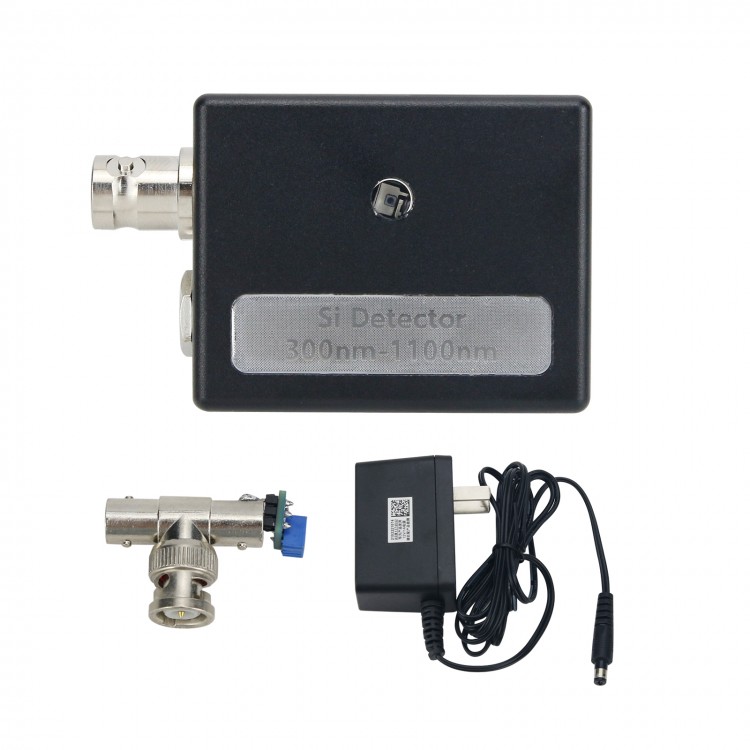
| Quantity | 3+ units | 10+ units | 30+ units | 50+ units | More |
|---|---|---|---|---|---|
| Price /Unit | $109.27 | $107.04 | $103.70 | $99.24 | Contact US |
 BN320 380-780nm Handheld LED Spectral Illuminometer CCT/Lux/Ra Testing with 4-inch HD LCD Touch Screen
$273.04
BN320 380-780nm Handheld LED Spectral Illuminometer CCT/Lux/Ra Testing with 4-inch HD LCD Touch Screen
$273.04
 Secondhand Imported UP19K-50L-H5 Laser Power Energy Meter 90W/15J Rang & Software Display for GENTEC
$538.14
Secondhand Imported UP19K-50L-H5 Laser Power Energy Meter 90W/15J Rang & Software Display for GENTEC
$538.14
 F999M Portable Professional Leakage Detector for Water Pipes/Heating Pipes/Fire Hoses Leakage Detection
$498.30
F999M Portable Professional Leakage Detector for Water Pipes/Heating Pipes/Fire Hoses Leakage Detection
$498.30
High Speed Photodiode Detector Photodetector Specially Designed for Pulsed Laser & Continuous Laser
Features:
- Imported high-speed photodiode for Hamamatsu.
- Wavelength response range: 300nm~1100nm.
- The material of the detector is silicon, and the photosensitive diameter of the probe is less than 0.5mm. The default is that free space light enters the probe. If required, a FC flange can be attached to the front of the probe so that users can directly access the detector with optical fiber. Please specify in advance when purchasing. The detector shipped by default does not come with FC flange.
- Cut-off frequency: >1GHz.
- Rising edge: <1ns.
- Output voltage range: 0-12V (12V voltage supply).
- The output impedance inside the detector is 1MΩ. In order to obtain a suitable response speed, users must connect an appropriate resistor in parallel at the output of the detector. In order to maximize the response frequency, the output of the detector must be connected with a resistor of 50 ohms to 100 ohms in parallel (generally 50 ohm terminals can be connected in parallel, and oscilloscopes with a bandwidth greater than or equal to 300 MHz also have 50 ohm impedance for selection). The smaller the resistance of the parallel output terminal, the higher the peak power of the incident optical signal, otherwise the lower the output voltage. Therefore, users need to find a balance between bandwidth and voltage. Generally speaking, the detection pulse width is hundreds of nanoseconds, picoseconds or femtosecond laser pulses, and the output end of the detector needs to be connected in parallel with 50 ohm-100 ohm resistors. To detect 500μs to 500ns laser pulses, the detector output needs to be connected in parallel with a resistor of 1K-10KΩ. To detect laser pulses of several hundred ms to 500us, a resistor of 10K-100KΩ is required to be connected in parallel at the detector output. If it is used for detection of greater than 500ms or continuous laser, the detector output does not need a parallel resistor. However, if the output voltage is too high, or to eliminate the influence of natural light, a 100k resistor or potentiometer can be connected in parallel. Doing so reduces outside noise and also limits the amplitude of the output voltage.
- Power supply voltage is 9~24VDC.
- It can be used to detect ultra-fast pulsed lasers (such as femtosecond and picosecond lasers), nanosecond laser pulses, and quasi-continuous wave lasers in the us or ms range. It can also be used to directly detect the intensity of continuous laser and non-laser light sources.
Package Included:
- 1 x Photodetector
- 1 x 12V DC regulated power supply
Packaging Details:
- G.W.: 0.55kg
Note:
- Detectors with amplification can be customized, which are divided into two types: 1) RF amplification (1MHz-100MHz); 2) Weak signal amplification, with adjustable gain. Contact us for the price before purchasing.